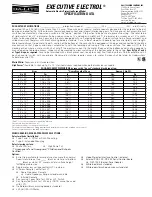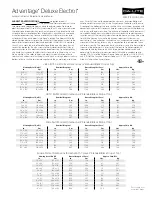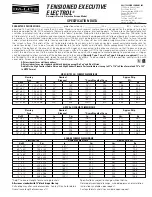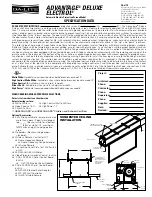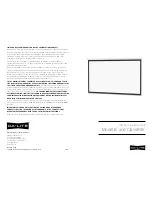
ENGLISH – Motorized screen user manual
Specifications are subject to change without notice. E&OE
Doc: XL Series – HOME CINEMA MODULES Installation Manual rev3 | 21.05. 2013
Please verify that you are working with the latest revision of this document before specifying your screen.
Page 8
05 WARNINGS AND RECOMMENDATIONS FOR CORRECT USE
Our screens are suitable for indoor use at normal temperature (20 - 25 °C) and humidity conditions. Special precautions are necessary for outdoor use, especially as regards
temperature levels and the presence of dust. Exposure to temperatures of over 50 °C can cause permanent deformation of the screen’s flatness, or the screen to come away
from the roller.
Avoid prolonged exposure of the projection screen to solar light to prevent yellowing of the same (ensure that exposure to solar light does not cause the screen to reach said
temperature level).
Since electrostatic charge tends to accumulate on the projection screen (which is made of PVC), attracting dust, excessive dustiness in the projection environment can
deteriorate the optical quality of the screen (see projection screen cleaning instructions).
WARNING: Do not manually force the screen’s unrolling: this could result in the motor being damaged or the screen’s case to come away from the wall mount brackets.
Do not allow children to play with the screen’s control panel. Keep remote control out of children’s reach.
Monitor screen movement and allow no-one near it until it is completely closed.
The following operations: blocking, preventing or forcing the screen’s movement, hanging or swinging from it, adding or applying any object to the screen or backdrop,
modifying the screen’s structure – are strictly forbidden and could result in damages to the screen’s rolling system and ensuing hazard to persons and things.
06 CLEANING AND MAINTENANCE
Screens and their projection surfaces are delicate and must be cleaned with great care, according to the following instructions:
Never use solvents, chemical or abrasive products, or pointed tools to clean the surface.
Avoid contact with other materials (varnishes, inks etc) as they might be impossible to remove from the canvas.
FABRIC MATT WHITE, HIGH CONTRAST, 3D WHITE:
Remove dust from the case with a soft, clean cloth and a non aggressive detergent as necessary.
Clean the projection screen with a soft, clean, damp cloth, and a neutral or alcohol-base detergent as necessary. Since rubbing the screen with a cloth during cleaning operations can cause electrostatic
charge to accumulate, we recommend the subsequent application of an antistatic liquid with a clean cloth, to avoid dust being attracted again
GENERIC PROFILE: Remove dust from the case with a soft, clean cloth and a non aggressive detergent as necessary
VELVET PROFILE: Clean profile with a soft clean cloth, or a brush with soft, antistatic bristles. A vacuum-cleaner brush may be used, provided its bristles are soft and perfectly clean.
STRUCTURE and ANCHORING BRACKETS:
The state of the product and the anchoring capacity of its brackets must be checked regularly. In case of canvas deformation or rips, or loosening of structural
components such as brackets or screws, action must be taken immediately to clear the area around the screen and avoid hazard to people and things, replace the defective component and restore the
product's functionality.
07 INSTALLATION INSTRUCTIONS
WARNING:
It 's absolutely forbidden to install the screen on mobile walls or unstable cables,the brackets must be applied on surfaces that ensure in the time your distance. When
installing the screen use plugs and screws suitable for the screen’s weight and for the type of wall or ceiling on which the mount brackets are to be fixed, based on the following criteria
Screen width up to cm
160
200
250
300
360
410
520
620
Overall weight
Kg 20
Kg 25
Kg 30
Kg 35
Kg 45
Kg 50
Kg 100
Kg 150
Secure the brackets to the ceiling or wall considering a maximum distance of 5 cm from the screen’s lateral edges, as shown in the picture on the left.
CEILING INSTALLATION
Proceed as described in picture 1, bring the screen close to the brackets (pos.1); block the rear part of the screen by tilting it slightly (pos.2); push the screen upwards until it
slides into the bracket (pos.3); tighten the three screws on the bracket as far as they will go (pos.4).
WALL INSTALLATION
Proceed as described in picture 2, bring the screen close to the brackets (pos.1); block the rear part of the screen by tilting it slightly (pos.2); push the screen upwards until it
slides into the bracket (pos.3); tighten the three screws on the bracket as far as they will go (pos.4).
FIG. 1
FIG. 2








